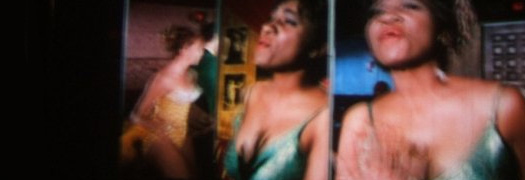
Features | Festivals
Electric Eclectics 2009
By Joel Elliott | 21 August 2009
:: Photos by Moira Campbell
Since most CMG readers won’t know where Meaford, ON is, I invite everyone to consult a map of Southern Ontario. If you position it just right it looks like an elephant, its trunk curling right up to Detroit—which is not where you want your trunk to be—and its tail consisting of the Bruce Peninsula, Meaford nestled somewhere around its asshole. It’s in that general asshole area that I was more or less bred from the time I was five and on. I’ve lived here again for the better part of a year; I suppose I don’t hate it and deep down suspect that everyone with small-town origins either still lives there by default and wants to get out, has moved on and has similar attitudes towards it as a snake does towards shed skin, or has grown comfortable with it and justifies it as the best alternative to the closest generic metropolis. Secretly, we accept the duality of gemeinschaft/gesellschaft so readily we lose sense of our ability to actually transform spaces we inhabit, assuming that a place has an impenetrable nature before anyone even exists in it. Strange, since I think everywhere has some mixture of security and shared interests, anonymity and antagonism.
Conceptual art, especially of the interactive variety, has a weird place in this situation, not only because of the rather obvious and probably deceptive idea that non-representational art belongs properly to cities (though I thought so again when I spent a summer out in a rural community on the BC coast, where the prolific and mostly well-meaning art consisted largely of basket-weaving and, at best, a kind of Cézanne-lite landscape painting), but also because audience participation doesn’t always (or even usually) have any kind of community, goal-oriented aspect to it. An ongoing installation of the weekend was a kind of twisted canopy with a continuous light projected on it but filtered through some kind of multi-faceted glass object so it produced after-image shadows across the canvas after someone walked in front of it. Added to this were trip-wires in the places where the canopy attached to the ground, which triggered various sound-effects, adding a distorted wind-chime component to the piece. But the installation was largely confronted on an independent basis, the small crowd hanging back until called by some unseen impulse to go rub corners with it.
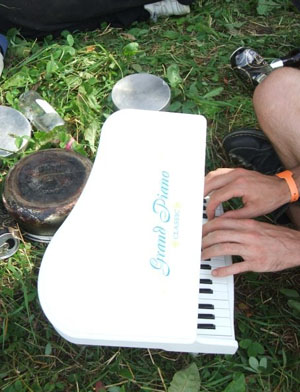
But the way the tintinnabulations resonated across the hillside—and the degree to which, on the first night anyway, the scattered installations were confronted spontaneously and without previous knowledge of how they worked, as if they occurred quite naturally—was what made the experience more than it would have been in a gallery space. Moreover, with little more than 100-150 people there at any given time, this wasn’t a Burning Man-type spectacle. Where at any larger festival there would be nauseous rows of tents in every direction, here there was just space: only a few kilometres up the road is a tank range (Meaford’s most notable landmark), but here everything seems untouched. There was an ephemeral quality to it—the hill, which dropped steeply beyond the canopy, was a pocket for wind the entire weekend. It’s like the part in Thomas Pynchon’s Against the Day where a Tuvan throat singer stands in some windy Mongolian enclave and the narrator can’t decide whether the wind is resonating through his voice or vice-versa.
This phenomenon came to an apex with Carla Bozulich on Saturday evening as the sun was going down. Here, there was no mistake, it was her who summoned the wind, or at least foretold it. She called out to the audience: “Swim to me / and you / and you / and you…You may have to tie me down / You may have to hold me underwater / Just to keep me from screaming.” The audience didn’t seem to connect that well, but maybe it was just a deeply-internal type effect. Lawn chair dude in front of me kept laughing about the word “irritainment,” as if that was something really clever that no-one else had ever thought of, so I moved in front of the stage and lay down in the grass so the wind and music was something that seemed to flow over me. “The sound inside the sound/inside the sound/inside the sound.” Bozulich’s lyrics are ridiculous if you try to add them up into anything, but as a pure translation of whatever deep spirits her music conjures up, they are perfect and brutally honest. As if she’d just turned her alt-country origins inside out; from simple major/minor chords to one single chord.
Towards the end of her performance, she brought up Damo Suzuki, one of at least three times he would appear on stage that weekend. This was his best, and I’d like to think it would have been more than one song, except it started pouring within 5 minutes, and when he came back after the rain had stopped, it was with his own band. Or rather, whatever band he’d intended to play with this weekend, since he apparently never plays with the same musicians twice. The idea of having the former vocalist of Can playing within a few kilometres of where I grew up is obviously huge for me, though I think it’s safe to say that a never-ending world tour will eventually, mathematically speaking, end up close to everyone’s home.
The reality of the awkwardness of his set took a long time for me to accept. Though it could just as easily have been one of his less successful outings: he was off and growling/wailing without restraint from the outset, and the band struggled to catch up with him, eventually settling for an endlessly-rising drone without any real dynamics. But I wonder whether the spontaneity of his shows doesn’t gel well with the fact that the focus is inevitably on him. He did, after all, play with Mars Volta, the dark overlords of jamming without any regard to what the other musicians around you are doing. Can knew what to do with Suzuki: just witness Future Days (1974), where his voice finally retreated into the background before leaving the group altogether.
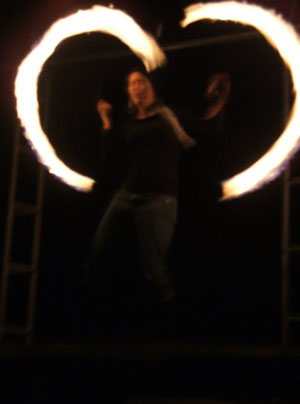
But I wanted to like it: to spite Lawn Chair Dude, to feel more connected to the artists than the rest of the audience, which I (correctly or not) perceived to be mostly curious on-lookers. There were other enthralling moments from the more experimental end of the festival: Lukas Ligeti, whose vibraphone and effects evolved over the course of his set from abstraction to something resembling calypso music mixed with IDM, and gradually proving he was actually wickedly talented at the instrument he was playing. Kunst Oder Unfall (“Art or Accident”) consisted mostly of spoken-word poetry over electronics, with the woman doing the speaking holding up various childhood objects. She might have been reading a grocery list for all the German I know but the effect was potent and occasionally hilarious—though, as is typically the case with avant-garde music, the crowd either didn’t see the humour or (more likely) were under the impression that such a response wasn’t validated or encouraged by the artists themselves.
There were other installations, too, around the fringes of the stage, easing the transition between the performance and the real world, the art and the accident. The haunting absence of the artist, leaving only their entrails. A few relatively hostile, possibly even malevolent, obstructions between the stage and our campsite: a theremin on a pendulum, motion-sensored, with a flashlight attached, in the back of a trailer behind several curtains, like a peep-show. A passive-aggressive robot, with a cone-shaped body and glowing head, who lunged at you when you came near it. I heard tales that someone was hiding in the bushes with a remote control, in which case I’m impressed at his restraint in terms of not making the thing just go berserk. It takes considerable talent to harness subtle, seemingly aleatoric menace.
There was supposed to be a Tony Conrad installation in a bathroom somewhere, but I never found it. Perhaps tiny mics on the side of the Porta Potty bowls captured the tinkling and plunking of the day’s waste, and we’ll see an obscure, German-only release come out sometime in the next six months. There was a silo with hanging orbs which, when touched, slightly altered the music (very Autechre-y IDM), but in a way I couldn’t wholly determine, as if the piece’s intention was to confront the listener with his/her own limitations as a reciever/transmitter. In an impromptu jam at our campsite this dude started singing everything that came into his head, no matter how banal, and it strikes me that self-sacrifice is something that art should strive for with the full knowledge that it can never be achieved. You hear me, dude?
Finally, on the side of one of the trailers there was a continuous projection of various old show tunes and velvety exotica: go-go boots, sets covered in white satin, Nancy Sinatra peering out luridly from that bouffant like it was a fortress. It was a weird occurrence of high-camp in an otherwise fairly-serious festival, but in a stoned haze there’s something just as confrontational here as in every other exhibit: those smiles that refuse to cease, misogyny creeping into a light caress of a thigh, the whole thing fabricated in a way that makes it seem like it’s destined to collapse at any second.
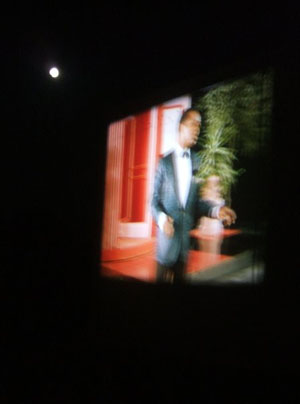
Meanwhile I still feel like a tourist: there is a strict divide here between the paid attendants (me) and the volunteers/musicians which, considering the turnout, is probably close to a third of everyone there. There’s a whole space open only to the latter, which I’ve seen through pictures contains an elaborately-decorated studio space, but I’m apparently only relegated to the ephemera of the weekend. My friend (also, a paid attendant) is even given serious flack by the owner of this farm for venturing back there in search of some water. I try to ignore this black spot on the weekend but it continually creeps in, as if the owners (the place is called the “Funny Farm,” which lodges in my brain in a bad trip kind of way) were completely oblivious to the degree to which the festival otherwise challenges the divide between performer and audience. Perhaps the gesture is one of eschewing spectatorship, privileging those who contribute artistically or logistically, but this is my weekend to be a neutral observer and at various levels of intoxication an obstruction can provoke a serious internal crisis, even if there’s nothing behind it.
Maybe it was forecasted by Friday night’s scrappy set from Toronto’s own I Can Put My Arm Back On, You Can’t, but a seismic shift happened when Holy Fuck took the stage close to midnight on Saturday. Electric Eclectics isn’t by any stretch of the imagination a purist’s avant-garde music festival, nor would an area like this be able to sustain a three-day event without actually allowing itself to be eclectic from every perspective. Still, I felt a twinge of guilt after what was almost relief at their appearance. Maybe it was Suzuki’s rather baffling set, maybe it’s the fact that there’s not a lot of novelty left for me in the type of out music featured here—which is to say that I have a lot invested in it, spend a lot of time listening to it on my own, and have some idea of how rare a mind-melding session really is. Holy Fuck are almost a sure thing right off the bat: there’s nothing overly complex about their music, and very little opportunity to fail drastically. The two effects-guys faced each other with the bass and drums in between them, each loop building off of the last, feeling like the highest possible plateau until the next phase busts out and makes everything that came before it feel like the band was holding out. The climax is all an illusion propogated by your heart-rate while dancing, which may be why the band feels so intrusive and out-of-place in a home listening environment, like coming across a Richard Simmons workout while channel-surfing and eating Doritos on the couch.
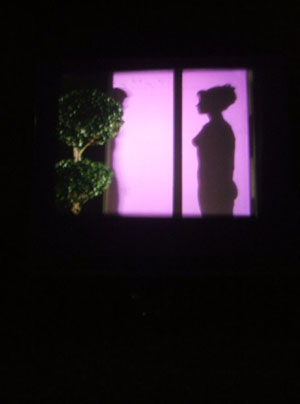
It was strange to be a stranger and yet be in the place which essentially raised me, surrounding myself with the kind of music that I came to identify with some time after I left the area. Whether I like to admit it or not I am, cough, an elitist, and coming home to this is a bit like finding out your mom’s into Arrested Development. Realizing that the outer fringes of music are completely open and accessible to everyone—even if no-one really knows what to do once they’re there—is also the beginning of a long process of coming to terms with the ugly mass of sound and matter which even Anthony Braxton has to dive into head-first to re-emerge clutching beauty just above the surface, head still in the thick of it.
Even an old acquaintance of mine, who I worked with back when I was playing for youth church services in the area, was there. I missed her own band’s performance, but on Sunday night she contributed vocals to a set by DBMG/RAF (Die Baader-Meinhof Gruppe/Red Army Faction), a Coil/Throbbing Gristle-type industrial project by Owen Sound’s own Joshua Richardson, which I for some reason was oblivious to until now. Named after West Germany’s violent anti-capitalist organization from the late 20th century, the political basis seemed like something of an empty provocation—and without any clear relationship to the dude at the side of the stage running a buzzsaw across a series of metal pipes and shooting off fireworks—but the music was frequently beautiful. My friend sang on a track called “Gaza” while ominous aerial footage of bomb targets played behind it: a rare encounter with decent hometown-sprung music that seems to be fixated halfway across the world, which I guess is appropriate.
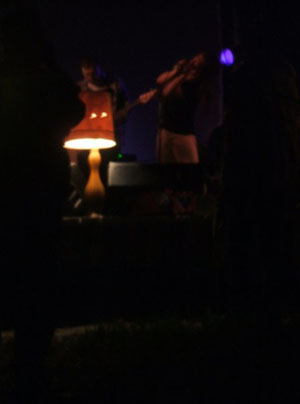
Later that night we set up a small fire in a hollowed-out barbecue—the best we could do since the property didn’t have a fire permit—and I ran blindly through the neighbouring cornfield. This is still the most vivid memory of the weekend: head down and trying to run as fast and as far as possible without running into someone or tripping, attempting to position myriad voices around me, being completely oblivious to everything except the tiny spaces in between the giant stalks. Even in a festival where interactive environments are set up to encourage free expression and participation, I find myself making a playground where I’m not supposed to be.
But on Monday morning, packing up and ready to leave, I see a woman standing, her back to me, arms out at about a 20° angle from her body, just kind of being in the wind, as if there were no other action to take at this point. I remember how much I love crawling out of the wreckage of a morning-after—feeling like I’ve shed that urgent need to talk, act, soak up my environment that always comes with the evening, and thus can now do so quite freely. I realize in retrospect that watching other people interact with that light/sound canopy was actually profoundly communal. Their movements—and mine, presumably—were tentative, like baby steps. Being immersed in an environment like this isn’t immediately gratifying, but when you’re released into the real world, like the slack after an elastic’s been stretched to its limit, you find your body seems to have grown into itself.





